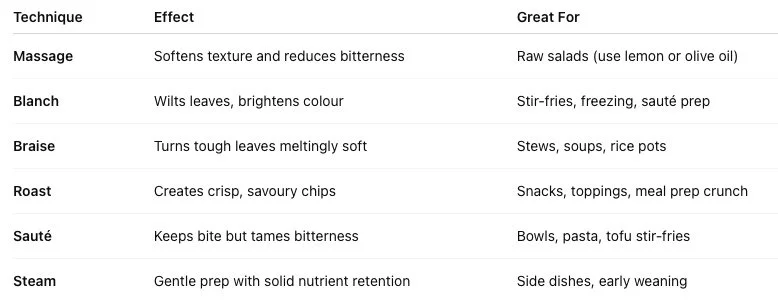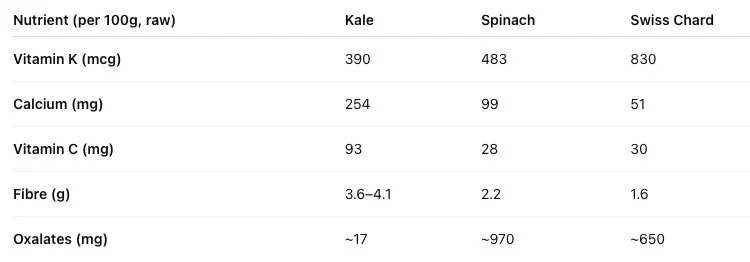Beyond the Hype – Why Kale Deserves a Second Chance
Kale was once the hero of green smoothies—until it became the butt of health food jokes. From “superfood” status to “over it” fatigue, the backlash came fast.
But kale never asked for the spotlight.
Long before the wellness industry co-opted it, kale was simmering in Tuscan soups, sizzling in Ethiopian kitchens, and growing quietly in backyard plots. It’s time to clear the air—and the plate. Kale isn’t bland. It’s been misused. It’s not boring. It’s been misunderstood.
Let’s give kale a fair chance by learning what it really is—and how to cook it well.
🥬 Not Just One Leaf: Meet the Kale Family
Kale isn’t a single variety—it’s a whole group of leafy greens cultivated for their hardiness, texture, and nutrient density.
🔎 Note: Gai Lan (“Chinese broccoli”) is sometimes called “Chinese kale,” but botanically it belongs to a different variety group—B. oleracea var. alboglabra. It’s typically treated more like broccoli in both flavour and cooking style.
🔥 The Real Problem? We Forgot How to Cook It
Most kale backlash comes from one mistake: treating it like lettuce. Raw kale, especially curly, is tough and bitter. But heat, acid, and technique transform it.
Here’s how:
💡 Massage works by breaking down cellulose and triggering mild enzymatic changes that mellow bitterness. Don’t overdo it—or it turns mushy.
💧 Steaming keeps vitamin C intact. Blanching reduces bitterness but leaches water-soluble nutrients like B vitamins and folate.
🌏 Culturally Rooted, Not Health-Washed
Before kale was trendy, it was humble, hearty, and traditional:
🇮🇹 Ribollita (Italy) – Cavolo Nero stars in this peasant soup with beans, bread, and veggies reboiled for depth.
🇵🇹 Caldo Verde (Portugal) – Slivers of Portuguese kale (couve galega) swirl through potato broth with garlic and smoked sausage.
🇪🇹 Ye’abesha Gomen (Ethiopia) – Kale or collard greens stewed with onion, garlic, nitre kibbeh, and often ginger or chillies.
🇯🇵 Kale in Kobachi & Tempura (Japan) – While not traditional, kale (often Tuscan) appears in small vegetable sides and is sometimes lightly battered and fried.
These aren’t "clean eating" trends—they’re real meals. Kale was always meant to be cooked with fat, acid, spices, and time.
🧠 The Nutritional Truth – More Than a Buzzword
Kale is often praised for its nutrients, but understanding what makes it special (and safe) matters just as much as the numbers.
✅ Low in oxalates – Kale doesn’t block calcium absorption like spinach. A huge win for bone health.
✅ Rich in vitamin K, C, and fibre – All supporting blood clotting, immunity, and digestion.
⚠️ High pesticide residue – Kale often ranks on the EWG Dirty Dozen list. Choose organic when possible.
⚠️ Vitamin K & warfarin – People on blood thinners shouldn't avoid kale, but should eat it consistently and speak with their doctor.
⚠️ Goitrogens – Raw cruciferous veggies can mildly suppress thyroid function in iodine-deficient individuals. Cooking deactivates these compounds. Unless you’re eating raw kale daily in huge quantities and lack iodine, the risk is minimal.
🍲 How to Actually Enjoy Kale
Try these tested, tasty approaches:
Sautéed kale + garlic + lemon – a fast and foolproof side.
Braised with miso and tofu – rich, umami-laden, and hearty.
Kale pesto with cashews and lemon – blended raw but softened and bright.
Kale chips – olive oil, nutritional yeast, smoked paprika.
Add to risottos, lentil soups, or stir-fries – cooked low and slow or flash-fried fast.
💚 Bonus: Kale reheats well, making it a meal-prep superstar.
🌱 Kale and Plant-Based Living – The Perfect Match
In a plant-based kitchen, kale pulls its weight.
Calcium without dairy
Iron with vitamin C to enhance absorption
Texture variety for bowls, braises, and crunch
Protein partners: tofu, tempeh, beans, seeds
For those shifting towards more plant-forward eating, kale provides the backbone for meals that nourish, satisfy, and comfort.
💬 Final Thought – Kale’s Not Over. It Was Just Misunderstood.
Kale isn’t a clean-eating cliché. It’s a dark leafy green with global roots, rich nutrients, and serious flavour potential—when cooked like it deserves.
If you gave up on kale when it was raw, bitter, and chewy, try again. Braised, sautéed, or massaged with lemon and love, it becomes something else entirely.
A green you’ll actually want to come back to.




